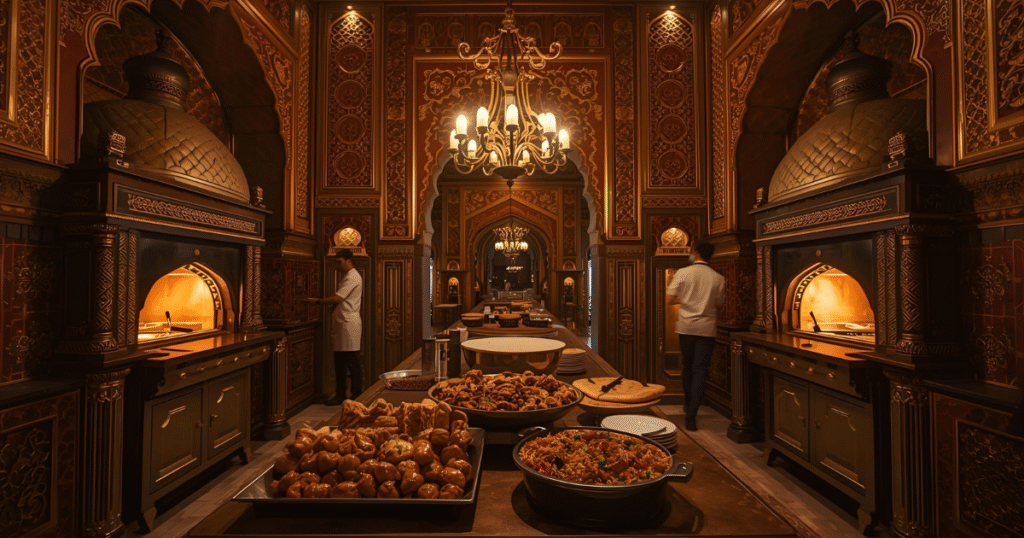
The Mughal Royal Kitchens were more than cooking spaces—they were living symbols of culture, diplomacy, and power. The grandeur of the Mughal Empire wasn’t just reflected in palaces, gardens, or jewels; it was also in the legendary feasts that defined their courts. Food in the Mughal era wasn’t only about nourishment; it was about showcasing imperial wealth, refinement, and artistry.
From smoky kebabs fresh out of the tandoor to fragrant biryanis slow-cooked in sealed pots, Mughal cuisine blended Persian elegance with Indian richness. Even today, when we enjoy a Mughlai korma or a plate of biryani, we’re tasting the legacy of an empire that ruled not only with swords but also with food.
So why are the Mughal kitchens considered legendary? Let’s step inside and uncover the secrets of their organization, culinary artistry, and the royal banquets that made them unforgettable.
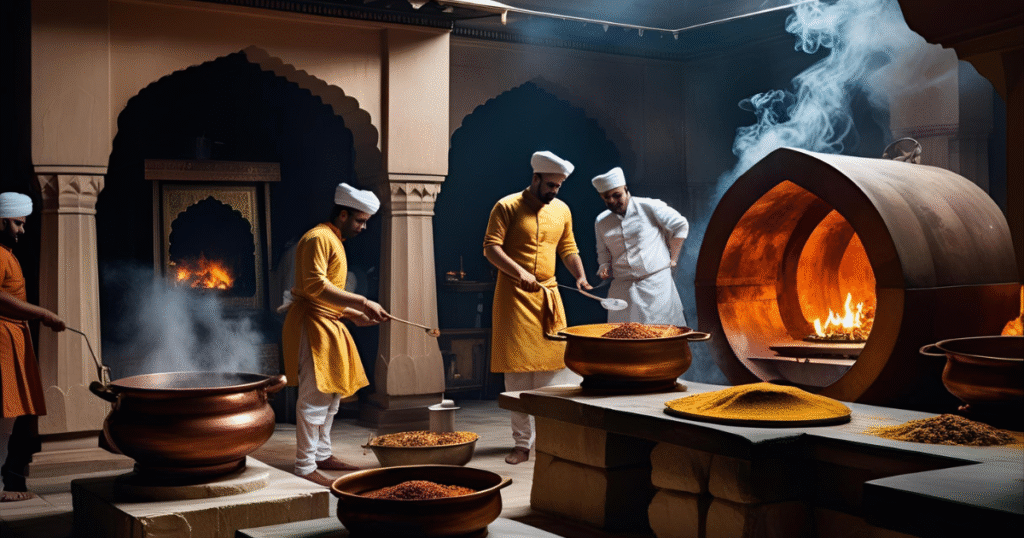
1️⃣ The Splendor of Mughal Royal Kitchens (Bawarchi Khanas)
The Bawarchi Khanas were not ordinary kitchens. They were massive, well-structured complexes that operated like small cities.
- Hundreds of chefs, helpers, and tasters worked under strict supervision.
- Specialized teams prepared breads, meats, sweets, and beverages.
- Food tasters were appointed to ensure both quality and safety for the emperor.
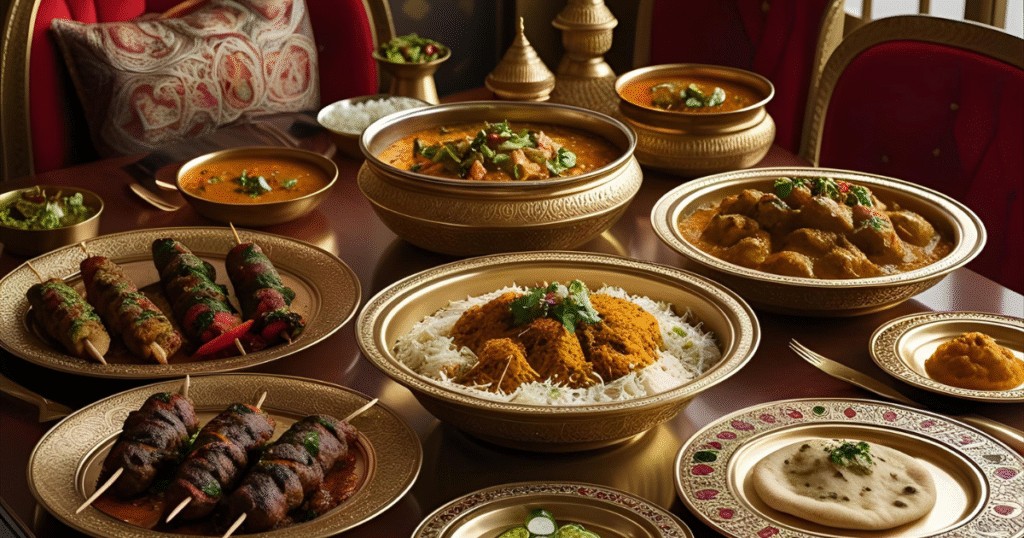
2️⃣ Signature Dishes That Defined Mughal Cuisine
The Mughal royal kitchens gave birth to dishes that remain icons of South Asian food today. These were not just meals—they were works of art crafted to delight the emperor and showcase luxury.
- Kebabs: From juicy seekh kebabs grilled on skewers to shami kebabs flavored with lentils and spices, and tender boti kebabs, Mughal chefs elevated meat into delicate bites of smoky perfection.
- Biryani & Pulao: Perhaps the most famous legacy—saffron-infused rice layered with tender lamb or chicken, nuts, and raisins. Pulao was lighter, while biryani carried richer flavors from slow-cooking (dum).
- Kormas & Curries: Creamy, slow-cooked gravies blending yogurt, cream, ground nuts, and spices. These dishes, often garnished with saffron and rose water, became the soul of Mughlai food.
- Sweets & Desserts: Royals indulged in Shahi Tukda (bread soaked in sweetened milk and garnished with nuts), firni, gulab jamun, and sheer khurma during Eid. These sweets symbolized celebration and abundance.
👉 Kebabs, biryanis, and kormas were court favorites—slow-cooked to perfection. Sweet delicacies like shahi tukda, firni, and gulab jamun delighted the royals. Heavy use of dry fruits, saffron, rose water, and ghee elevated these recipes into timeless treasures.Each of these dishes combined Persian techniques with Indian spices, creating flavors so timeless that they remain beloved across the world today.
3️⃣ Exotic Ingredients of Mughal Kitchens
The Mughals spared no expense in sourcing ingredients, combining the best of India with imports from across Asia.
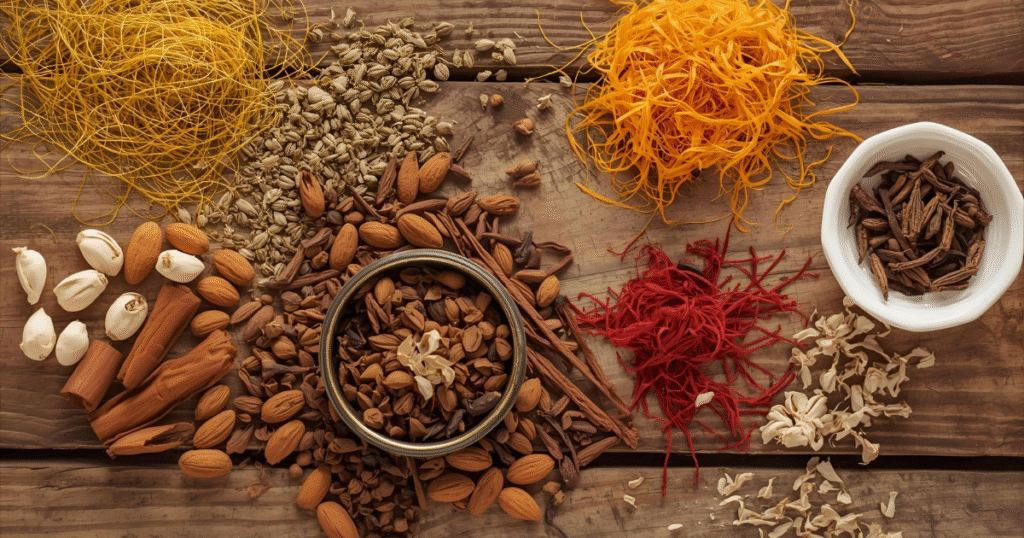
- Imported Luxury:
- Persian saffron for color and aroma.
- Afghan raisins, figs, and apricots for sweetness.
- Turkish rose water for fragrance.
- Central Asian pistachios, walnuts, and almonds for richness.
- Local Treasures:
- Indian cardamom, cloves, black pepper, turmeric, and chilies.
- Seasonal vegetables like spinach, gourds, and onions.
- Rice and wheat as the staple grains.
- Signature Touch:
Heavy use of ghee, yogurt, and cream gave Mughlai dishes their richness, while edible gold and silver leaf (varak) turned them into symbols of royalty.
👉 This balance of imported and local produce gave Mughal food its unique depth, richness, and fragrance unmatched by any other cuisine.
4️⃣ Cooking Techniques That Changed Indian Food
The cooking methods perfected by Mughal chefs are still the backbone of modern Indian kitchens.
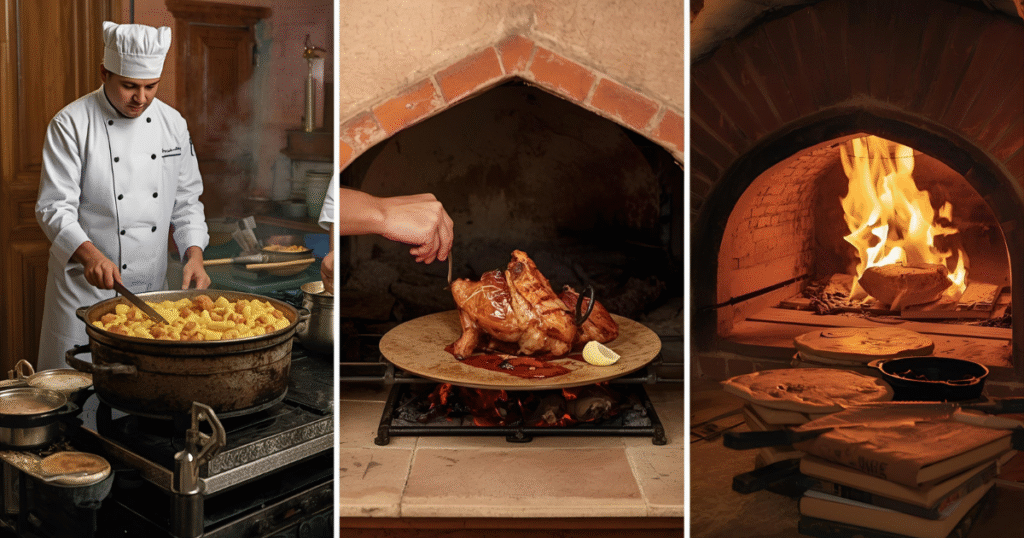
- Dum Pukht (slow cooking): Food was sealed in pots with dough, trapping steam and allowing meat, rice, and spices to cook slowly, locking in flavor and tenderness. This technique gave rise to the famous Hyderabadi biryani.
- Tandoor Cooking: Borrowed and refined by the Mughals, the clay oven was used to bake naan, tandoori roti, and roast meats. Its smoky char remains a staple in Indian restaurants today.
- Layering Flavors: Unlike one-step cooking, Mughal dishes layered spices, nuts, and aromatics in stages, creating deep, complex flavors. For example, rose water or saffron was often added at the end for a fresh fragrance.
👉 These techniques not only changed royal dining but also redefined Indian food culture, leaving a culinary blueprint that continues to inspire.
5️⃣ Food as a Symbol of Power
Food was politics on a plate in the Mughal empire.
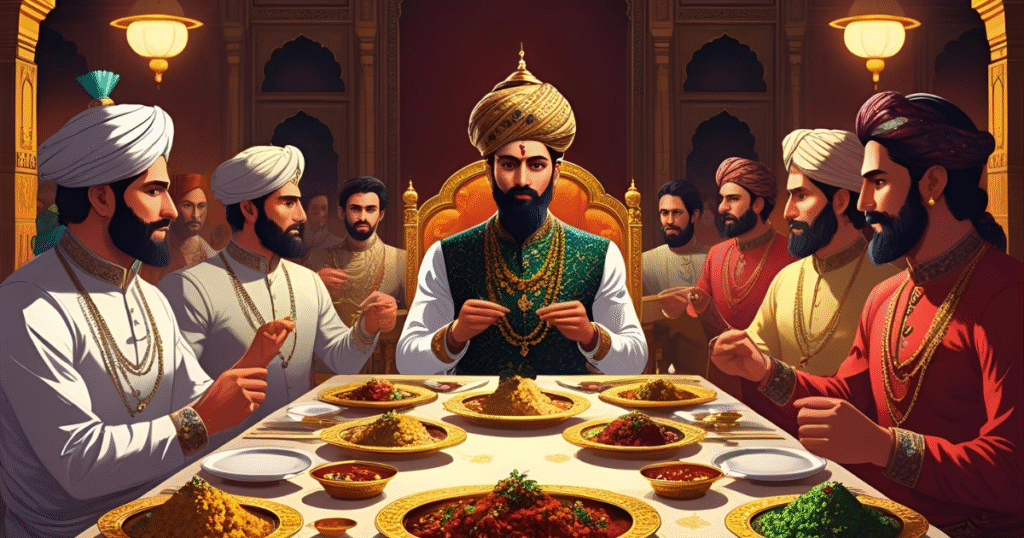
- Royal Feasts: Banquets were organized to impress nobles, cement loyalty, and dazzle foreign ambassadors. The sheer quantity and luxury of dishes served was a display of imperial wealth.
- Dining Etiquette: Food was served on gold, silver, or jade platters, and flavored with saffron, rose water, and sometimes even edible gold leaf, turning meals into theatrical displays of luxury.
- Diplomacy Through Food: Sharing a meal with the emperor was seen as an honor, while refusing such an invitation was a grave insult.
👉 Thus, in the Mughal courts, food was more than nourishment—it was a stage for diplomacy, power, and loyalty.
6️⃣ Cultural & Religious Influences on Mughal Cuisine
Mughal food was shaped by faith, tradition, and cultural fusion.
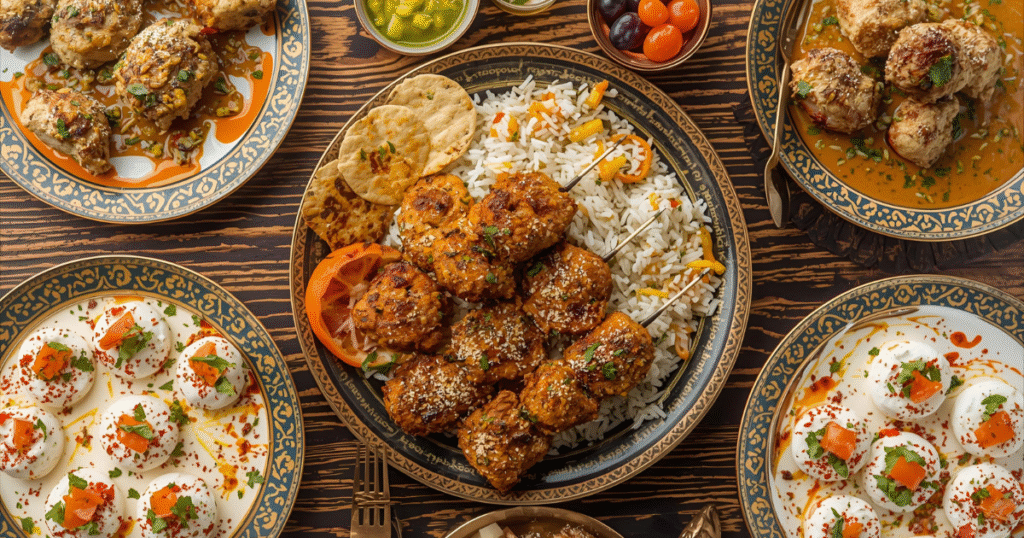
- Persian Heritage: Inspired dishes like pilaf, kebabs, sherbets, and desserts flavored with rose water and saffron.
- Indian Influence: Local spices like turmeric, cumin, and chili added vibrancy and heat, while rice and lentils became the backbone of daily meals.
- Religious Laws: Halal dietary rules were followed strictly—pork was forbidden, beef and lamb were common, and alcohol was rarely served.
- Festivals & Celebrations: Ramadan feasts included sheer khurma and fried snacks, while royal weddings featured elaborate multi-course meals. Indian festivals also blended into court life, adding ladoos, jalebi, and other sweets to the Mughal menu.
👉 This cultural fusion ensured Mughal food was adaptable, diverse, and timeless.
7️⃣ The Lasting Legacy of Mughal Cuisine
Even centuries after the fall of the Mughal empire, its culinary influence remains alive.
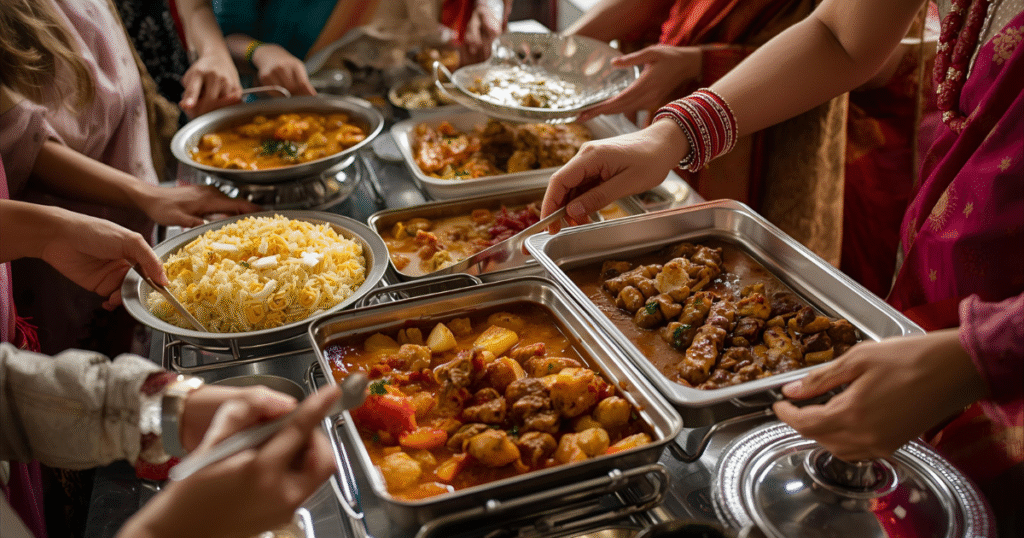
- Restaurants: Across India, Pakistan, and beyond, Mughlai dishes like kebabs, biryani, and kormas are centerpieces of restaurant menus.
- Home Kitchens: Generations of families have carried forward Mughal-inspired recipes, adapting them for daily cooking.
- Weddings & Festivals: Mughal cuisine remains the highlight of celebrations, from royal-style biryanis to creamy gravies and indulgent sweets.
- Global Reach: Dishes like butter chicken, naan, and tandoori—though modern evolutions—are rooted in Mughal traditions and loved worldwide.
👉 The aroma and artistry of Mughal food prove that the emperors didn’t just rule with swords and palaces—they ruled with food and flavor, leaving behind a legacy that still unites food lovers across the globe.
✅ Conclusion
The Mughal royal kitchens were far more than places of cooking—they were centers of art, power, and cultural fusion. With their lavish feasts, exotic ingredients, and innovative cooking methods, the Mughals didn’t just feed bodies; they fed identities, politics, and traditions.
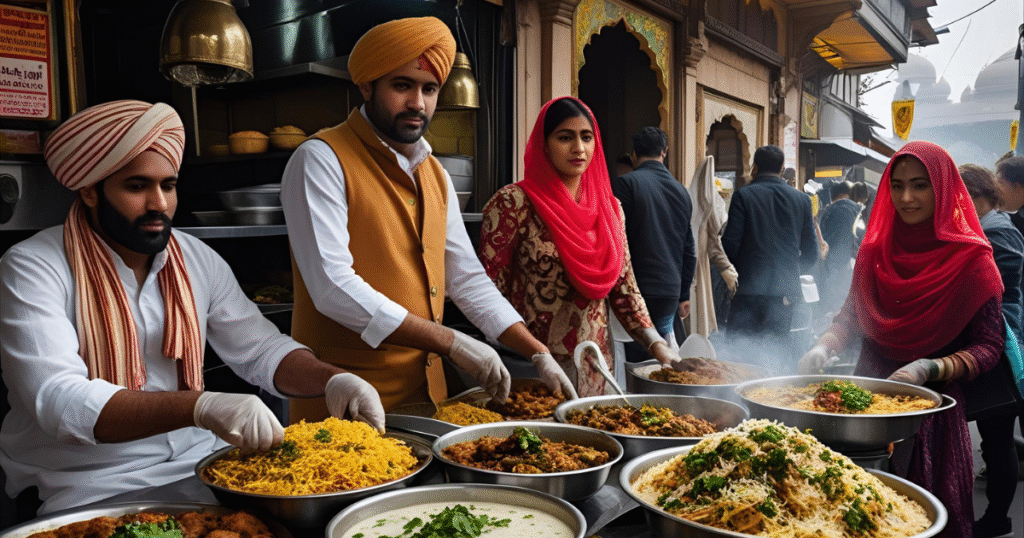
Today, when you enjoy a plate of biryani, savor a tender kebab, or indulge in a rich korma, you are tasting the living legacy of Mughal cuisine. Its aroma, artistry, and richness still unite food lovers across India, Pakistan, and the world.
👉 The Mughals ruled with swords and palaces, but they also ruled with food—and that is a power still felt centuries later.
❓ FAQs About Mughal Cuisine
1. What is Mughal cuisine known for?
Mughal cuisine is famous for its rich gravies, biryanis, kebabs, and desserts with saffron, rose water, and nuts.
2. What did the Mughals eat daily?
They ate breads, meats, rice, lentils, fruits, and sweets, while royals enjoyed grand feasts.
3. Is Mughlai food still eaten today?
Yes! Mughlai food like biryani, kebabs, and kormas are popular across India, Pakistan, and worldwide.
4. What cooking methods did the Mughals introduce?
They popularized dum pukht (slow cooking) and tandoor baking, still used today.
5. Why was food important in Mughal courts?
Food symbolized wealth, diplomacy, and cultural power.
